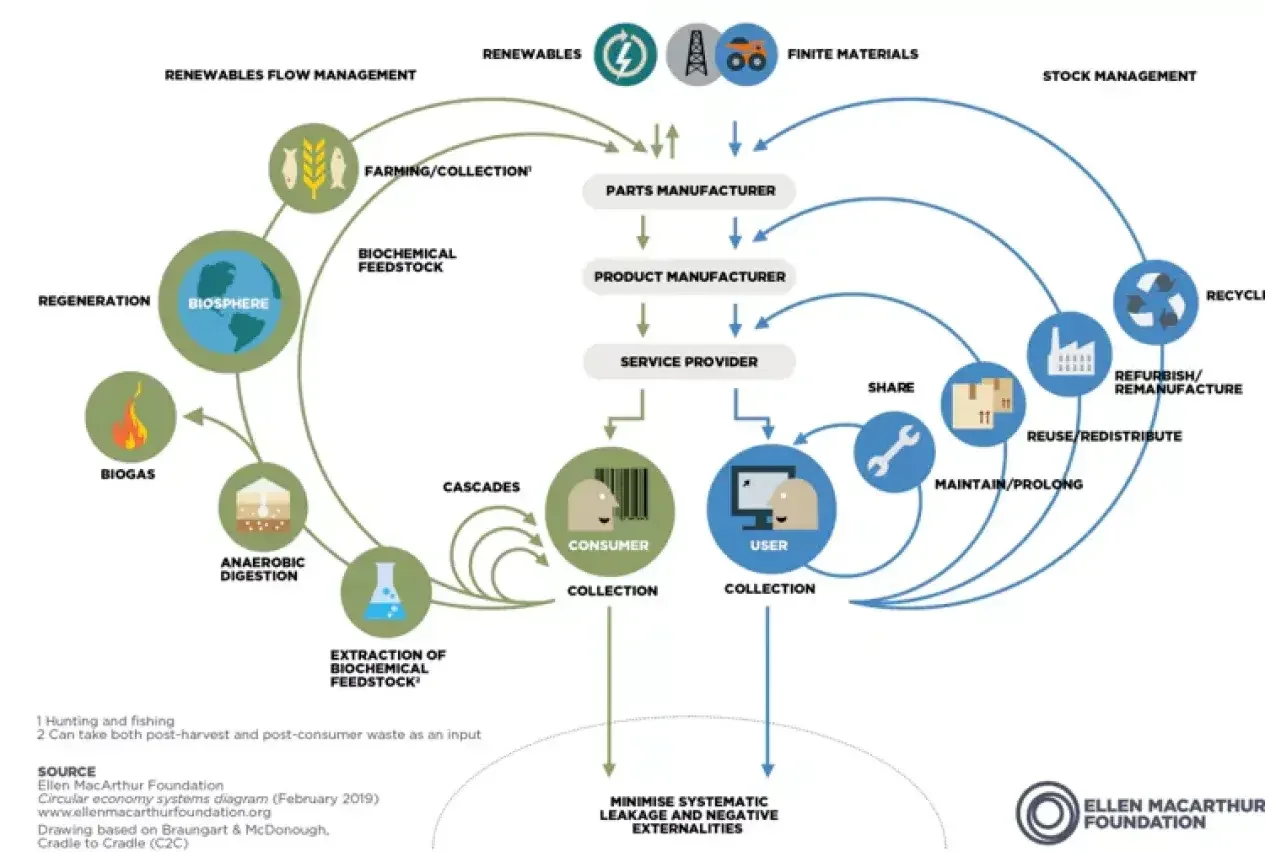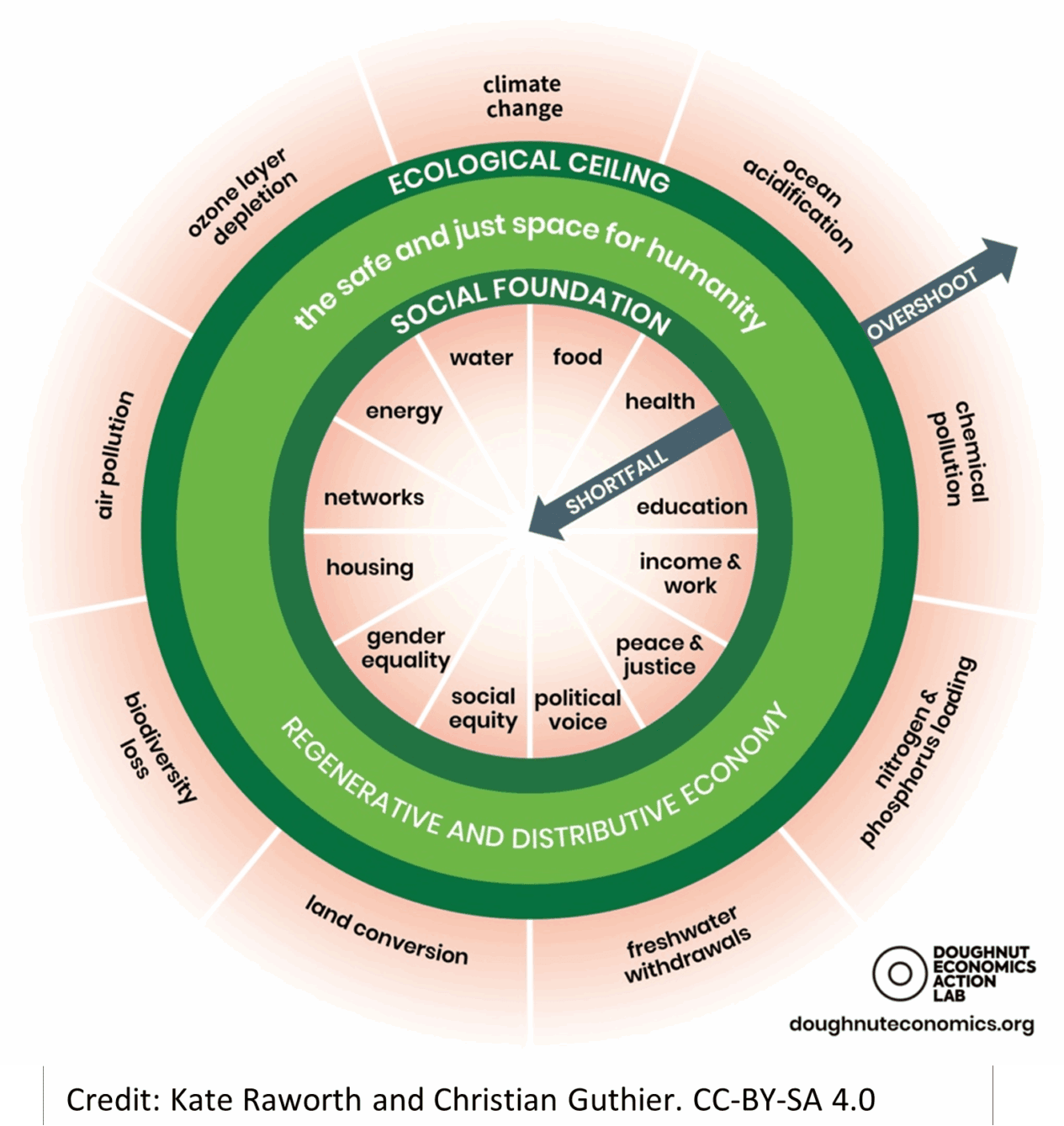A big question for today is, looking at the effects they have had, are our current business and economic models working? Are ‘market mechanisms’ balancing demand and protecting the planet and all its services and resources?
It would seem not, with climate change and pollution creating havoc in many places, biodiversity loss increasing apace and resource depletion biting. Do ‘trickle down’ economics actually trickle down? The gap between the richest and the poorest is widening year-on-year, so again, it would seem not. And progress on achieving the United Nations Sustainable Development Goals (SDGs) is painfully slow. Is it rational to pursue endless growth, ever-rising GDP, in a world with finite resources?
Many people and groups concerned about sustainability, including quite a few economists, think not, and new approaches have been developed. Possibly the best-known concepts are the Circular Economy and Doughnut Economics; the former being used as a basis for policy and legislation both in the UK and Europe, amongst other places, cities and businesses, and the latter starting to transform cities, regions, communities and elsewhere to become more sustainable and fairer.
Circular economy systems diagram.
Image credit: Ellen Macarthur Foundation.

The circular economy is probably the more familiar, and its roots go back a long way. Concepts including Cradle to Cradle, Performance Economy, Biomimicry, Industrial Ecology, Natural Capitalism, Blue Economy and Regenerative Design have all informed the work of the Ellen MacArthur Foundation, a global organisation originated in the UK and whose work is to support society in moving towards a circular economy, one that is regenerative and restorative. Its website is a fantastic learning and ideas resource, and well worth a visit.
Such an economy is not ‘just about recycling’, but a complete change in ways of thinking, designing and working. Some go back to very old models of paying for a service rather than buying goods – those of you old enough may remember when you rented televisions rather than buying them, and they would be mended for you when they went wrong. Newer versions of goods-as-a-service approach this in innovative ways – from paying per lux for lighting instead of buying the system to renting baby clothes during those first few months when they grow so fast.
The aim of the circular economy is that nothing should go to waste, pollution should not be created and natural systems should be regenerated.
It requires an industry to be innovative in approach – and print is an industry with an amazing track record for innovation. It also requires, as do all such models, systems thinking. The design and specifications need to consider not just the use phase of the product, but what it’s made of and how. The impacts that the materials you use have, both in mining or harvesting their constituents and in manufacture, including wastes created, are as important as your own production impacts. The other end of the life cycle needs to be thought about: what the stores can do with point-of-sale materials afterwards, for example, if they cannot be refurbished for reuse, and how to work with them on this. It’s about designing things so that they can be reused, use minimal amounts of material and are straightforward to recycle. The entire value chain is involved in the system.
Because circular thinking and production need to start at the design stage, policies for extended producer responsibility (EPR), aimed at driving circularity, put the responsibility for items at the end of life on the ‘producer’ – usually the brand owner (or importer for imported goods). This is where the decision makers. For the forthcoming UK EPR regulations for packaging waste, the intention is that not only will packaging volumes be reduced, but that modulated fees will encourage design for reuse or recycling.
Doughnut Economics, developed by Kate Raworth, goes much wider, addressing not just the overshoot – the extent to which we are overusing resources and adding pollutants beyond the planet’s regenerative capacity – but also the shortfall for meeting peoples’ basic needs. Hence the doughnut – as you can see, it’s a ring doughnut, and within the ring is the safe place. The hole in the middle is where people are missing out; the outer edge of the doughnut is the line we need to stay within to protect our home world. Many of the themes have been covered in previous articles about the UN SDGs. Again, the website has plenty of food for thought and inspiration.
The Doughnut of social and planetary boundaries.
Credit: Kate Raworth and Christian Guthier. CC-BY-SA 4.0

Much is written about how measuring wellbeing of a population would be a better measure than measuring GDP, but wellbeing is unattainable for those whose basic needs are not being met. The challenge is how to change this. Again, your value chain plays a part: even when you are a fair employer, looking after your staff, if you use suppliers and contractors with poor or unjust employment practices in their business or their supply chain, your business is part of the problem; the same applies to many aspects of running a company. And this is one of the reasons why there are so many supply chain questionnaires and audits coming the way of so many printers (and, for course, others). It’s only by asking, and checking, that you find out – and the organisations at the top of the chain are asking, so the next level down are asking, and so on down. And every business in our industry has their role to play in completing the chain. So the other big question is not ‘are we doing things right’, but ‘are we doing the right things?’
For more information and further reading on this subject, please find a list below of useful resources and tools that can be applied to concepts within your business.
Ellen MacArthur Foundation: https://www.ellenmacarthurfoundation.org
Doughnut Economics: https://doughnuteconomics.org
United National Sustainable Development Goals: https://www.un.org/sustainabledevelopment/